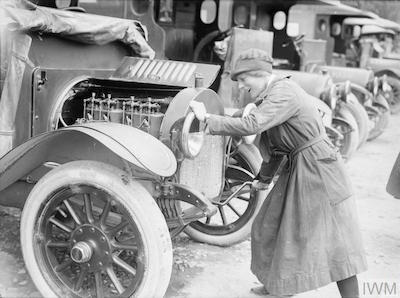
A member of the British Red Cross Society, Voluntary Aid Detachment (VAD) starts up the engine of her ambulance, Etaples, 27 June 1917. Copyright: IWM (Q 2446).
The First World War changed attitudes towards mental illness considerably after so many men returned from the fighting with serious psychological conditions. What came to be known as ‘shell-shock’ had a massive impact upon society during and after the war. Soldiers had been exposed to the constant sound of exploding shells for prolonged periods of time and the horrors of machine warfare had profound affects. The combination of constant gunfire, fighting in mud-filled trenches, and the results of using machines in warfare triggered nightmares and caused soldiers to develop constant anxious or hysterical behaviour.
There seems to something missing from this picture, however. What about the women who worked along the front line as nurses or ambulance drivers? Were they not affected too? The answer is yes, they were, but their suffering is now largely forgotten. At the time, women were simply sent home if they were seen as unable to stand the strains of war and their condition went untreated. For the most part these women were largely ignored. Yet, these women were just as brave as those soldiers fighting in the trenches or under the roasting conditions of the Mediterranean.
When looking through diaries and letters written by these women we see accounts describing the horrific injuries they helped to treat, the conditions they worked in, and the dangers they experienced. The conditions nurses and ambulance drivers faced were much the same as those the soldiers were fighting in. Casualty Clearing Stations were never far behind the front lines and could be just as mud-ridden as the trenches themselves. The dangers of being an ambulance driver were always high with the constant threat of artillery fire or gunshot fire. It was not unheard of for the nurses and ambulance drivers themselves to suffer amputations from falling shells, or broken bones from crashes when racing patients between first aid stations and base hospitals. Then there were the dangers of “secondary gas” from gas attacks. It was these conditions that saw many women suffer from similar psychological traumas as soldiers and instead of being treated these women were simply sent home to pick up the pieces alone.
We have started to see much more information about women in the First World War with the recent centenary of the conflict, although there sadly is very little on women and the psychological effects of war. To find out more about the roles women took in the First World War and read some of their truly inspirational stories, check out the Imperial War Museum’s podcast on¬†Women’s War Services,¬†and their Women in Wartime collections, or watch a WWI propaganda film.
You can also read the diaries of Edith Appleton, who was a nurse at the front, or watch the Anzac Girls TV series, which tells true stories about the nurses of the Australian Army Nursing Service.
Lastly, be sure to read The Forgotten Female Shell-Shock Victims of World War I, the article used for this blog.
-Claire Amundson
Junior Girl
Girl Museum Inc.
